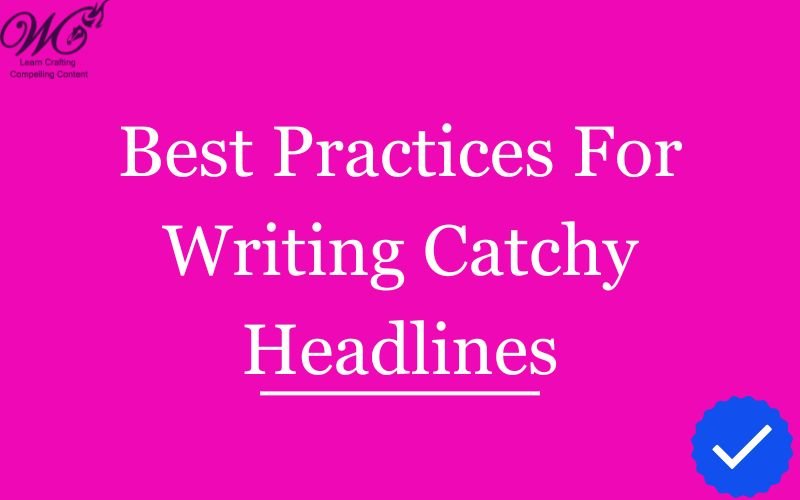As a writer, your headline is your first impression. It’s the first thing your readers will see, and it’s what will determine whether they click on your article or not. You can capture the attention of your audience by following these 10 Best Practices For Writing Catchy Headlines.
In this article, we’ll discuss the 10 best practices for writing Catchy headlines. Whether you’re a blogger, content marketer, or journalist, these tips will help you create headlines that grab your readers’ attention and make them want to click. A well-written content can help you to increase your conversion rate by up to 50%.

Best Practices For Writing Catchy Headlines:
1. Keep it Short and Sweet
One of the most important rules for writing a good headline is to keep it short and sweet. Your headline should be no more than 60 characters or about 8–10 words. This ensures that your headline is easy to read and doesn’t get cut off in search results.
2. Use Strong Action Words
Using strong action words in your headlines is a great way to grab your readers’ attention. Action words are words that convey a sense of urgency, excitement, or importance. Some examples of strong action words include:
- Discover
- Boost
- Transform
- Unlock
- Unleash
By effectively adding these types of words in your headlines, you’re telling your readers that your content is valuable and worth their time.
3. Be Specific
Another important rule for writing catchy headlines is to be specific. Your headline should give your readers a clear idea of what they can expect from your content. Instead of writing a vague headline like “10 Tips for Better Writing,” try something more specific like “10 Tips for Writing Attention-Grabbing Headlines.” this can make them more excited to open and check your content.
4. Use Numbers and Lists
Numbers and lists are a great way to make your headlines stand out. People love lists because they’re easy to scan and digest. Some examples of headlines that use numbers and lists include. Using Numbers and Lists can help you to get more engagement and resharing on social media.
- 5 Ways to Lose Weight Immediately
- 10 Reasons Why You Should Start Freelancing
- 7 Tips For Growing Your Social Media Following
Adding numbers and lists are helpful for Writing Catchy Headlines, this will give your reader a clear idea of what they are going to learn in the article.
5. Make it Emotional For Writing Catchy Headlines:
Emotional headlines are powerful because they connect with your readers on a deeper level. You can use Storytelling techniques to make it more personalized with your reader.
Check these examples of emotional headlines include:
Why You’re Not as Successful as You Could Be (And How to Fix It)
- The One Thing You’re Doing Wrong That’s Sabotaging Your Relationships
- How to Overcome Your Fear of Failure and Achieve Your Dreams
By tapping into your readers’ emotions, you’re making your headlines more relatable and engaging.
6. Use Keywords For Writing Catchy Headlines:
Using keywords in your headlines is important for SEO. Your headline should include the keywords you want to rank for, but make sure it’s still readable and engaging. Although SEO is necessary for Writing Catchy Headlines, never compromise quality for the sake of SEO.
7. Use Question Headlines
Question headlines are a great way to pique your readers’ curiosity. Here are some examples of question headlines include:
- Are You Troubling With Procrastination?
- Do You Feel Out of Ideas When Writing Social Media Posts?
- How Can You Overcome Writer’s Block?
With the strategy of asking a question in your headline, you are hitting on the pain points and problems your reader struggles with, and looking for answers.
8. Use Power Words For Writing Catchy Headlines:
Power words are words that evoke strong emotions in your readers. They’re words that convey a sense of urgency, excitement, or importance. It’s important to use powerful words for Writing Catchy Headlines to make your content interesting and compelling.
Some examples of power words include:
- Shocking
- Incredible
- Essential
- Unbelievable
- Surprising
- Secret
- Proven
- Instant
- Ultimate
However, it’s important to use powerful words in moderation and to make sure that the words you use are relevant to your content. Using too many of these words can make your content seem gimmicky and untrustworthy.
9. Use Humor (When Appropriate)
Humor is a great way to grab your readers’ attention and make them laugh. However, it’s important to use humor only when appropriate. Don’t try to be funny if it doesn’t fit with your brand or message. Here are examples of humorous headlines include:
- Why Procrastinators Are Actually More Productive (Yes, Really!)
- The Lazy Person’s Guide to Getting Things Done
- Why You Shouldn’t Trust Your Cat (According to Science)
Your content will be easy to memorize and shareable when it has a factor of humor.
10. Test and Optimize
Finally, it’s important to test and optimize your headlines. Try different variations of your headline to see what works best. Use tools to compare different versions of your headline and see which one gets the most clicks. You can more about SEO from the article Ultimate SEO Checklist.
It’s also important to optimize your headline for different platforms. What works on social media might not work on your website, so be sure to tailor your headlines to the platform you’re using. Testing and optimizing are necessary for Writing Catchy Headlines and making your content more visible and searchable for organic traffic.
Conclusion: Best Practices For Writing Catchy Headlines
Writing a good headline is essential for capturing your audience’s attention at first sight and driving traffic to your website. By implementing these 10 best practices for writing Catchy headlines, you’ll be able to create headlines that grab your readers’ attention and make them read your content.
Remember to keep your headline short and concise, use strong action words, be specific, use numbers and lists, make it emotional, use keywords, use question headlines, use power words, use humor (when appropriate), and test and optimize different variations of your headline for better performance.
With these best practices, you’ll be able to create headlines that stand out from the competition and get the visibility and engagement they deserve. You May love to read the article 10 Best Tools For Content Writers.
FAQs: Best Practices For Writing Catchy Headlines
How long should my headline be?
Your headline should be no more than 60 characters or about 8–10 words.
What are some examples of power words?
Some examples of power words include shocking, incredible, and essential.
Should I use humor in my headlines?
If it fits with your brand and message, then yes, humor can be a great way to grab your readers’ attention.

Nice article, and also very easy to understand for begginer writers, awsome effort.
You are a great content writer.
Massively appreciate this article.
It would help newbies a lot in crafting impressive headlines.
Thanks Abdul Haseeb for sharing your knowledge regarding content writing.